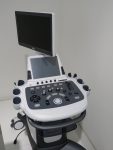
Taking into account that radiology is a term used to describe several forms of non-invasive medical imaging, we consider it significant to describe each of these types of medical imaging and provide you with details related to education requirements, salary, and job prospects.
The imaging types included in the field of radiology are diagnostic medical sonography (also known as ultrasound), x-ray, CT, MRI, and nuclear medicine.
The main difference among all these specialties is in the equipment used and the areas of the body evaluated with that equipment.
Furthermore, they represent a range of different career paths.
In our article, we will discuss different options for radiology specialty degrees, with the aim to provide you with all you need to know on how to become an ultrasound technician, x-ray technician, CT technician, MRI technician, and nuclear medicine technologist.
We will inform you about what degree levels are available for each imaging specialty, how much they cost, the length of each degree, admission requirements, and courses you will take as part of each degree.
Last, but not least, you will learn about the imaging types in detail, including their definitions, the role of the person responsible for administering the procedure, the type of equipment used, and salary ranges.
Page Navigation
Differences Between Radiology Careers: Pick a Specialty
Being that you are reading this, you definitely consider specializing, and here are some things to think about which we find useful when the young learner’s decision-making process is in question:
- Your level of interest in the intellectual content of the specialty
- The type of patients you’d work with
- Your personality match with the specialty
- Market demand and job opportunities
- Income potential
- Quality of life
- Issues facing the specialty area
- Research opportunities
The medical imaging field is constantly growing and developing and many different technologies are being used requiring more educated professionals to work with the equipment.
If you are interested in the field of sonography, you have plenty of choices for specialization, but you should know the difference amongst them.
Ultrasound imaging produces computerized images from sound waves reflected by internal organs.
Magnetic resonance imaging (MRI) uses magnetic fields and radiofrequency to provide visualization of the body’s internal structures.
Molecular imaging uses small amounts of radioactive markers to produce details of the structure and function of organs and tissues.
Which one of the above-mentioned techniques will be used depends on the kind of patient you will have.
All of them have different needs, and sonographers find it great to work with a certain population group such as children, women, or the elderly.
Getting a certificate in any of the fields is very significant and the American Registry for Diagnostic Medical Sonography (ARDMS) is the main organization that offers specialty exams in abdominal/small parts, Ob/GYN, vascular, and breast.
If you wish, you can hold more than one credential, thus increasing your value, job prospects, and income.
We know that the most difficult moment is when you need to pick a specialty.
When sonography is in question, you would be glad to know that most of the courses you take will be the same and you can expect to take courses in anatomy and physiology, in medical ethics, patient care, and pathology.
A significant part of your studies will be focused on the clinical side, learning how to actually operate the imaging machines.
However, you will need to take the specific courses for a specialty you have chosen and they are all discussed below.
Diagnostic Medical Sonography
Diagnostic medical sonography, or ultrasound as it is better known, is a popular and high demand form of radiology due to the fact that its negative effects are low.
Sonography uses high-frequency sound waves that are transmitted from the probe – a camera used by the sonographer, to show an image of the patient’s anatomy on a screen.
The people who perform sonograms/ultrasounds are known as sonographers, sonogram technicians, ultrasound technologists, ultrasound techs, or ultrasound technicians.
Ultrasound is considered the best tool for medical imaging as it does not use any form of radiation
Plus, it is a cost-effective and very safe method for evaluating anatomy.
The majority of people see sonograms as pictures of unborn babies when a woman is pregnant, but sonography is also used for more other purposes.
The sonographer evaluates pediatric and adult hearts, blood vessels throughout the body, and all abdominal parts like the liver, kidneys, pancreas, and spleen.
It can be easily administered by the technologist causing no discomfort from the patient, it is often the first line of defense in imaging.
What kind of education and credentials you will need to possess to become a sonographer vary by employer, type of environment, whether you work in a hospital or private practice), and which subspecialty you are working in.
Ultrasound technicians can have a certification only, or gain more advanced degrees, such as associate, bachelor’s, and even master’s degrees.
So as to become a sonogram technician, a degree is not required for application to an entry-level sonography job.
However, the most important factors that can extremely affect your employment are typically graduation from an accredited program and registration with the ARDMS after you pass their board exams.
If you decide to enroll in a certificate/associate degree program, you should have in mind that they are often 18-24 months in length.
After this period, you will be equipped with appropriate education and clinical experience to become a board-certified sonographer, meaning that you will learn the skills to enter the workforce on a shorter timeline.
Another option to choose from is a 4-year degree, often called a degree in Diagnostic Medical Imaging, but may be listed as an emphasis to a Bachelor’s in Health Sciences (BHS).
Obtaining a bachelor’s degree will increase your job prospects, possible salary and you can reach career goals of working in administration, but this may require a 4-year degree.
Master’s degrees specifically in ultrasound are not common but are available only at some schools.
A more extensive research-based course load is necessary and in the majority of cases, this is a program that allows someone with a bachelor’s in a different healthcare field to complete the ultrasound courses offered for a bachelor’s, in addition to extensive research and obtain a master’s degree.
Ultrasound courses are very common to those offered by medical imaging programs, with a special emphasis on physics.
In order to be allowed to sit for a registry exam, sonographers are required to pass a Physics and Instrumentation board, so during the coursework, ultrasound programs will have 1-2 courses specifically dedicated to the physics involved in the specialty.
Salary Range for Ultrasound Techs
- Associate: $43,800-$109,400
- Bachelor’s: $52,600-$97,050
- Master’s: $65,100-$95,100
X-Ray
X-ray, or radiography, is a common radiology specialty and an x-ray technician uses an x-ray machine, which produces a focused beam of radiation, to image a specific part of the body.
The dense tissue of bones blocks the radiation waves, so they produce a white image on the screen.
X-ray is often used to evaluate bones and the skeleton, while a chest x-ray is frequently used to evaluate the lungs and heart tissue.
This is a less attractive way of determining diseases, being that x-ray exposes both the patient and technician to radiation, but efforts are taken to reduce the exposure.
Furthermore, the benefits of the imaging actually outweigh the risks of radiation exposure.
Radiography is an inexpensive and easily accessible form of medical imaging.
The majority of employers will only require completion of an accredited program and appropriate credentialing, but there are some x-ray technicians that re required to hold a variety of degrees up to master’s degrees, to get the job.
X-ray technicians, very similar to sonography technicians must meet some hiring requirements that often include completion of an accredited program and licensure through the American Registry of Radiologic Technologists.
Obtaining a certificate or associate degree to necessary to be completed as this training is a basis to begin working.
This can be achieved in 12-24 months and upon getting a Bachelor of Science in Radiology Technology degree, or BSRT, you will be equipped with skills that may make you eligible for cross-training in other imaging modalities or move to a graduate-level.
Bachelor’s programs may be a 4-year program or a program that allows the credits from an associate program to be transferred in and count towards the completion of the bachelor’s degree.
A master’s degree in radiologic sciences is a path to becoming a radiologist assistant who is an extension to radiologists and whose duties are more demanding and responsible, such as participating in advanced patient care and procedures.
You can choose this path if you want to make a career in radiology education.
The coursework will vary based on the desired career outcome – advanced practitioner, administrator, or educator.
Doctorate programs in radiology are also available to the most advanced students and they often have a focus on multiple sub-specialties of radiology.
They may be combined with a medical school in an MD/Ph.D. program, allowing the provider to practice independently as a radiologist.
A doctorate program has a high level of research involved and students must take specialized courses for x-ray programs including radiation exposure and protection as well as image acquisition and interpretation.
X-Ray Technician Salary by Degree Level
- Associate: $39,750-$63,550
- Bachelor’s: $41,050-$94,250
- Master’s: $51,000 – $94,350
- Doctorate: $51,800-$136,700
MRI Technologist Information
Magnetic resonance imaging, MRI, is a unique specialty within radiology as this tool uses magnets and radio waves to produce images.
MRI is often used to evaluate soft tissue and bones of the spine, vasculature, and brain and should only be done by professionals called MRI technologists or technicians.
MRIs are performed in both hospital and outpatient settings.
The results are read by radiologists.
MRI machines are designed so that the patient lays down and is inserted into a tube-like structure, so they are quite large.
Furthermore, they are also quite noisy and require ear protection.
All in all, MRI is an excellent resource for seeing anatomy in more detail, but it is also a costly procedure and is utilized only in situations that justify the costs.
Most MRI careers require an associate degree from an accredited program, but some employers may ask for additional credentialing and state-specific certifications.
MRI careers require registry with the American Registry of Radiologic Technologists and you can reach this certification by choosing one of the two common paths.
You can either reach an associate degree in MRI or complete a radiography registration, followed by obtaining a certificate in MRI.
An associate degree is a common requirement for working in MRI and you can select going specifically into a program for MRI.
However, many students decide to complete their MRI education as part of a broader education in radiology.
A bachelor’s degree in MRI is often an emphasis on a bachelor’s degree in Advanced Radiology Sciences.
A bachelor’s degree is necessary for people who wish to work in healthcare leadership.
If this is not the level you want to reach, there is a higher level of education.
You can hold a bachelor’s degree in a field related to MRI or radiology and decide to obtain a Master of Science in Magnetic Resonance Imaging.
Master’s programs place an emphasis on research, clinic practices, and leadership.
For people who want to do more research and management, a Ph.D. in Medical Imaging with an emphasis on MRI is available.
Courses specific to basic MRI programs are MRI safety, imaging principals, and imaging procedures.
Salary Range by Degree Level
- Associate: $60,000-$89,700
- Bachelor’s: $60,050-$84,200
- Master’s: $67,300-$81,000
- Doctorate: $72,400-$90,400
CT
Computed tomography, also known as CT, is also a form of radiology and a CT machine is very similar to an MRI machine.
Actually, a patient is inserted into a tube-like structure while laying down, and the technologist or technician ensures that images are taken of the necessary body structures.
CT is often used to detect cancer, as it can detect a tumor’s size and location, as well as produce three-dimensional images of the area.
The usage of CT, which is not the most cost-effective type of imaging, is justified as it can be lifesaving.
It is also used to detect internal bleeding in a trauma patient, being that the level of definition is often greater than ultrasound or x-ray.
So as to be able to find a job in computed tomography, you will be required to be registered with the American Registry of Radiologic Technologists.
An associate degree or completion of a radiology program with an emphasis on CT will often take 18-24 months to complete and is obligatory to get the appropriate job.
An option for a four-year degree of a Bachelor of Science in Radiologic Sciences with an emphasis in Computer Tomography is available for those that desire a more advanced education, thus, making them eligible for advanced positions such as healthcare leadership.
Computer tomography students will also take courses that have an emphasis on the physics of the modality.
Salary Range
- Associate: $59,500-$86,600
- Bachelor’s: $64,150-$86,950
Nuclear Medicine
Nuclear medicine is a unique type of radiology due to the fact that the technician does not only image specific body parts with the equipment, but also uses a special low dose of radioactive materials called radiopharmaceuticals.
This radioactive material allows for visualization of the anatomy with the use of the special machine, called a gamma camera, that detects the radiopharmaceuticals and converts them to an image.
What makes this filed special is that nuclear medicine can not only be used for the detection of disease, but also for treatment.
Nuclear medicine is a highly specialized field of radiological imaging and it is expected that it requires appropriate education.
Not too many people are interested in Nuclear Medicine degrees, but if you are one of those eager to earn this degree, you will need to be certified through the credentialing body for nuclear medicine – the Nuclear Medicine Technology Certification Board.
An Associate of Applied Science from an accredited program will be enough to get started in an entry-level position at some organizations.
However, associate degrees are not the most common level of education in nuclear medicine, as these professionals always have a desire to advance and learn more.
The most common degree held in this specialty is a Bachelor of Science in Nuclear Medicine Technology.
A Master of Science in Nuclear Medicine Technology can be obtained only if you wish to work at a higher level in the field of nuclear medicine.
Finally, there are those who wish to be prepared to work in the world of research within nuclear medicine and they should obtain a doctorate level education or a Doctor of Philosophy in Nuclear Medicine.
Nuclear medicine programs stand out from other radiology programs by providing education on the radiopharmacy aspect of the field, as well as specific courses for gamma camera operation.
Salary Range
- Associate: $65,050-$95,850
- Bachelor’s: $62,200 – $86,400
- Master’s: $76,050-$86,450
- Doctorate: $81,750-$96,250
Radiology Degree Length and Costs
How long you will need to attend classes and how much you will need to pay for them can differ a lot.
We would like to mention that the length and cost of a bachelor’s degree in sonography are about the same as the length and cost of a bachelor’s degree in CT or X-Ray.
So, here is a list of possible degree levels and their length, as well as average costs of programs, which will help you determine if the program fits your schedule and budget:
- Associate – 18 months-2 years – $30,000-$40,000
- Bachelor’s – 4 years – $50,000-$60,000
- Master’s – 2 years – $65,000-$80,000
- Doctorate – 4-6 years – $75,000-$92,000
You can always make use of loans, grants, and scholarship opportunities available to you
Program Accreditation
When looking for an ideal program for yourself or your child, you should take into consideration many factors, but the first one that has to be on your mind when sonography degrees are in question is the accreditation of the chosen program.
This means that you need to make sure you choose a school recognized by CAAHEP as this is the number one accrediting body for top healthcare education programs.
The majority of states do not regulate the field of sonography and do not require a certificate after your graduation, but this is another thing to consider.
Employers will likely want to know you went to a CAAHEP approved school and that you are qualified by the American Registry of Diagnostic Medical Sonographers (ARDMS) which can b achieved if you pass their exam.
So, everyone who would like to work as an ultrasound technician and who want to be more attractive than other candidates must be aware of the licensing and credentialing requirements for each state.
Job Growth for Radiologic and MRI Technologists
If we take into consideration the Bureau of Labor Statistics’ data, jobs for medical imaging technologists are expected to grow 13% in the next decade which is much faster than the national average.
The states with the highest rates of employment for radiologic technologists are:
- California
- Texas
- Florida
- New York
- Pennsylvania
The states with the highest rates of employment for MRI technologists are:
- Florida
- California
- Texas
- New York
- Michigan








